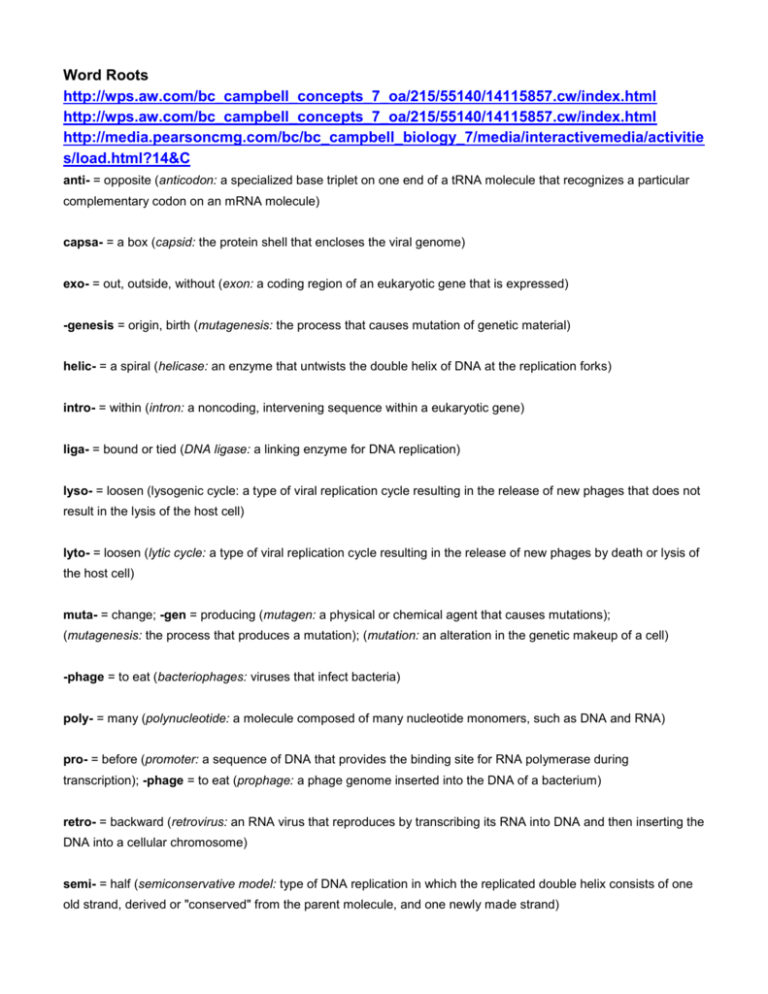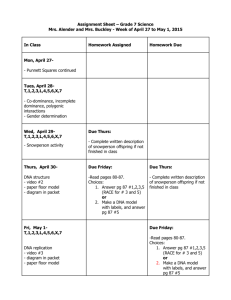Root Words
advertisement

Word Roots http://wps.aw.com/bc_campbell_concepts_7_oa/215/55140/14115857.cw/index.html http://wps.aw.com/bc_campbell_concepts_7_oa/215/55140/14115857.cw/index.html http://media.pearsoncmg.com/bc/bc_campbell_biology_7/media/interactivemedia/activitie s/load.html?14&C anti- = opposite (anticodon: a specialized base triplet on one end of a tRNA molecule that recognizes a particular complementary codon on an mRNA molecule) capsa- = a box (capsid: the protein shell that encloses the viral genome) exo- = out, outside, without (exon: a coding region of an eukaryotic gene that is expressed) -genesis = origin, birth (mutagenesis: the process that causes mutation of genetic material) helic- = a spiral (helicase: an enzyme that untwists the double helix of DNA at the replication forks) intro- = within (intron: a noncoding, intervening sequence within a eukaryotic gene) liga- = bound or tied (DNA ligase: a linking enzyme for DNA replication) lyso- = loosen (lysogenic cycle: a type of viral replication cycle resulting in the release of new phages that does not result in the lysis of the host cell) lyto- = loosen (lytic cycle: a type of viral replication cycle resulting in the release of new phages by death or lysis of the host cell) muta- = change; -gen = producing (mutagen: a physical or chemical agent that causes mutations); (mutagenesis: the process that produces a mutation); (mutation: an alteration in the genetic makeup of a cell) -phage = to eat (bacteriophages: viruses that infect bacteria) poly- = many (polynucleotide: a molecule composed of many nucleotide monomers, such as DNA and RNA) pro- = before (promoter: a sequence of DNA that provides the binding site for RNA polymerase during transcription); -phage = to eat (prophage: a phage genome inserted into the DNA of a bacterium) retro- = backward (retrovirus: an RNA virus that reproduces by transcribing its RNA into DNA and then inserting the DNA into a cellular chromosome) semi- = half (semiconservative model: type of DNA replication in which the replicated double helix consists of one old strand, derived or "conserved" from the parent molecule, and one newly made strand) trans- = across; -script = write (transcription: the synthesis of RNA on a DNA template); (transduction: the transfer of DNA from one cell to another via a bacteriophage); (transformation: a phenomenon in which external DNA is assimilated by a cell); (translation: the process in which an amino acid sequence is produced by reading an RNA transcript) virul- = poisonous (viroid: a short stretch of viral not enclosed in a protein coat); (virus: an infectious agent that requires a host cell for reproduction) Word Roots -centesis = a puncture (amniocentesis: a technique for determining genetic abnormalities in a fetus by the presence of certain chemicals or defective fetal cells in the amniotic fluid, obtained by aspiration from a needle inserted into the uterus) co- = together (codominance: phenotype in which both dominant alleles are expressed in the heterozygote) cyto- = cell (cytogenetic maps: charts of chromosomes that locate genes with respect to chromosomal features) di- = two (dihybrid cross: a breeding experiment in which offspring of a cross of parental varieties differing in two traits are mated) geno- = offspring (genotype: the genetic makeup of an organism) hemo- = blood (hemophilia: a human genetic disease caused by a sex-linked recessive allele, characterized by excessive bleeding following injury) hetero- = different (heterozygous: having two different alleles for a trait) homo- = alike (homozygous: having two identical alleles for a trait) mono- = one (monohybrid cross: a breeding experiment that crosses offspring of a cross of parental varieties differing in a single character; monosomic: a chromosomal condition in which a particular cell has only one copy of a chromosome, instead of the normal two; the cell is said to be monosomic for that chromosome) pedi- = a child (pedigree: a family tree describing the occurrence of heritable characters in parents and offspring across as many generations as possible) pheno- = appear (phenotype: the physical and physiological traits of an organism) pleio- = more (pleiotropy: when a single gene impacts more than one characteristic) poly- = many; gene- = produce (polygenic: an additive effect of two or more gene loci on a single phenotypic character) re- = again; com- = together; bin- = two at a time (recombinant: an offspring whose phenotype differs from that of the parents)







